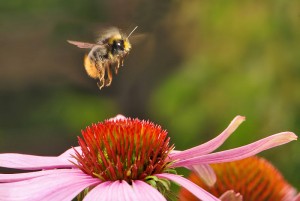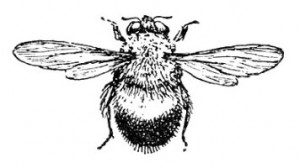Many people have heard the tale of bumblebees not being able to fly. How could this be possible? This little white lie was created without any documentation of who made the calculation and when.In the story, the unnamed aerodynamicist was at dinner with a biologist and became interested in the topic of aerodynamic capabilites of the wings of bees and wasps. The aerodynamicist assumed the wings were smooth, flat plates and that they would be easy susceptible to wing stalling. He claims that his calculations “proved” the bee to be incapable of flight because it cannot (in terms of wing size or beats per second) fly with the degree of wing loading necessary. His assumptions however, were completely wrong. He later discovered that he made a mistake when examining a bee’s wing under a microscope—but it was too late. The monster myth was already created and into the hands of the public.
Speaking about the myth, David Wilkinson says, “Someone must have produced some sort of story many years ago, long before anyone could understand insect flight, based on aircraft wing theory. The aerodynamics of 4 flapping wings is very complex. Lighthill did some work on insect aerodynamics 30 to 40 years ago that showed it was quite different to conventional aircraft aerodynamics. He showed that, by bringing two wings flat against each other and then moving them apart, very strong vortices were produced which could generate unexpectedly large lift … The earlier ‘disproof’ was based on an inadequate model but the story has an instant and lasting attraction to the non-technical mind.”
Additionally, Michael Habib says that the story is used “in a derogatory sense to put down scientists and engineers” who are “(in the views of the story-tellers) unable to grasp something obvious to everyone else.” This story seems to try to tell these scientists and engineers to step back from their work and look at what is right under their nose. However, this method is contradictory because what is right in front of us is the fact that bumblebees can and do fly. It was believed by some scientists that insect wing cross sections generate lift and drag characteristics similar to those generated by the airplane airfoil. If this statement were true, Habib says yes, “they would indeed be grounded.” However, “bees don’t fly like airplanes.”
Unlike airplanes, insect wings are flexible and their changes are crucial to being able to produce lift. Due to insects’ viscosity, they are burdened with a considerable amount of air on them as they fly. Also, the air never reaches equilibrium on the wings of insects with high wing beat frequencies. Seemingly contradictory, they maintain a balanced imbalance of the airflow acting on their wings. The bumblebee’s combination of high wing beat frequencies and small size produces high lift coefficients, obviously enabling flight.
It has been discovered that the calculations made by those who claim the bumblebee cannot fly were solely based on “a simplified linear treatment of oscillating aerofoils” which assumes small amplitude oscillation. Basing calculations on this technique means ignoring dynamic stall, a flow separation that induces a large vortex above the wing and the lift of the aerofoil in regular flight produced by the vortex. John Maynard Smith claimed that because of the small wing area of bumblebees, they would not be able to produce enough energy to sustain flight. However, when Smith performed experiments he proved himself to be wrong. He used viscosity to disprove his own claim. Viscosity is the quantity used to express the magnitude of internal friction, causing something to be a certain consistency, which is measured in force per unit area resisting a flow. Smith used this to say that at the scale of such small insects their wings can “move” a large amount of air, relative to their size. Since they can achieve this, the energy it takes to sustain flight is not very high and therefore they most certainly can fly.
Works Cited:


One Comment
Lorena Barba posted on December 23, 2012 at 6:10 pm
Good post, Catherine! There is one sentence, though, that mis-stated something …
“Due to insects’ viscosity, they are burdened with a considerable amount of air on them as they fly.”
It should probably say “Due to insects’ size, they are burdened with a considerable amount of air resistance due to viscosity …” (the viscosity is a characteristic of the air, but it is felt more and more intensely as size goes down.